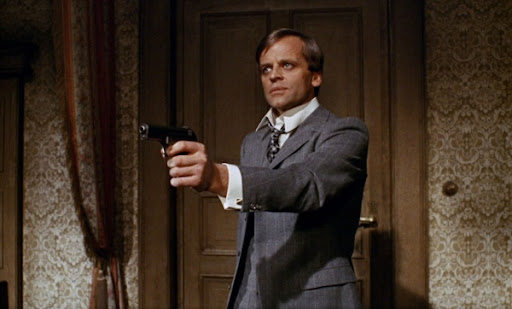
If you’ve been a horror movie fan for a significant length of time you have probably encountered the giallo in some form or another — Italian murder mystery films that run the gamut from Hitchcock-ian suspense to crime procedurals to proto-slashers. It’s a genre known for elaborate murders, lurid content, and over the top stylistic flourishes pioneered by iconic directors like Dario Argento and Lucio Fulci. While not unheard of there is a lesser-known brand of European suspense film that did serve as a kind of predecessor to the giallo — the German krimi. Short for kriminalroman — crime story — the term can be used to describe any kind of crime fiction. Though untold gallons of digital ink have been spilled over the debate of what can and cannot be called a giallo, krimi enjoys a fairly succinct definition among English speaking film fans. The core krimi are German language film adaptations of mystery stories by British writer Edgar Wallace produced by Rialto Films from the end of the 50s to the early 70s. Edgar Wallace was a prolific writer whose stories have maintained their popularity in Germany though he is probably best known in the U.S. as the author of the initial screenplay for King Kong. As their name implies, krimi are first and foremost crime stories but their focus on labyrinthine murder mysteries and their visual style — moody settings, killer POV, zooms — does lay some of the groundwork for giallo. Many of these films are horror-adjacent at best but some of the later examples ramp up the creepier elements already present in Wallace’s writing with gorier kills, mist shrouded castles, and always plenty of dungeons, hidden portals, and secret corridors. That is very much the case in Alfred Vohrer’s Creature with the Blue Hand from 1967 — a twisted tale of murder, insanity, a masked killer, and twin Klaus Kinskis!
Creature with the Blue Hand opens with a courtroom scene in which Dave Emerson — Kinski — is judged responsible for a murder and is committed to an insane asylum. Dave loudly protests his innocence as his family — including his twin brother Richard — looks on. The screen then erupts in blood spattered titles as Martin Böttcher’s propulsive jazz theme underscores a montage of the mayhem to come. Later in his cell at the asylum, someone slips Dave a key and he’s able to make his escape across the fog-cloaked woods to Castle Gentry — the Emerson family home. Dave’s escape coincides with the appearance of a menacing hooded figure who employs the titular hand — a blue steel gauntlet with retractable blades — to kill unsuspecting victims in and around Castle Gentry. Inspectors from Scotland Yard are summoned, and accusations fly while mysteries are pursued and family secrets are revealed. Why is the Blue Hand coming after the Emerson children? What does all this have to do with the asylum and its monocled director Dr. Mangrove? Whatever became of Lord Emerson in the first place?
The main thrust of Blue Hand is madcap action — coffins, poison, judo-chops, retractable batons, claw-cam, cabinets filled with snakes, and even a rat room. While Blue Hand is admittedly on the zanier side of things, the details make for a solid October watch. Both the asylum and Castle Gentry are packed to their cobwebbed corners with ominous shadows, skeletons, suits of armor, concealed passageways, and deadly traps. In a scene that could be transplanted directly into a Bava film one of the castle’s rooms is populated with mannequins positioned in various modes of death — hanging from the ceiling or face down with daggers buried in their backs. The murder scenes aren’t spectacularly gruesome, but the killer does ride around in a coffin in the back of a van and their weapon of choice is definitely cool. Arguably the most horrific moment in the film is when the shadowed silhouette of the hooded fiend can be seen in a covered window, and they slowly begin to tear through the curtain with the horrible, clawed hand.

You get a variety of stock archetypes in Blue Hand, but the acting is fine and some of the supporting players are fairly amusing. Dr. Mangrove is possessed of some truly sinister Teutonic mad scientist vibes, Scotland Yard’s Sir John is at turns hilariously oblivious and exasperated, and the Emerson’s butler Anthony can be found behind every screen or sliding panel — unflappable in the face of danger and clearly knows more than he lets on. For his part, Kinski is rather subdued but the identical twin schtick does have its moments. The humor in Blue Hand runs on the broad side and unfortunately leans on the denizens of the asylum for some of the gags. Still, the more successful bits are played at the expense of the wealthy or figures of authority.
If you’re a fan of older crime films or if you enjoy gialli that focus squarely on the central mystery, then the German krimi films are well worth your time. If you’re looking for something specifically for October viewing and can appreciate some 60s kookiness mixed in with your slate of slashing or undead gut-munching — Creature with the Blue Hand just might fit the bill. To call it an early slasher would be a stretch, but you still get a masked menace sporting a signature weapon and a cool watchlist choice outside of the usual spooky season suspects.





